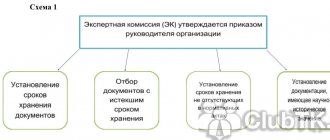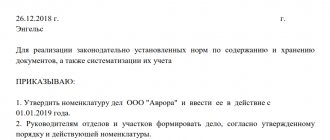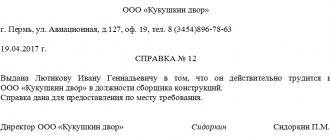What were your guidelines before the new Rules came out?
Before the approval of the new Rules, the archives of state authorities, local governments, organizations (hereinafter referred to as the archives of organizations) were guided in their work by the Basic Rules for the Operation of Organizational Archives[1], and some archives of organizations used a very old document - the Basic Rules for the Operation of Departmental Archives[2] . Both documents were not normative documents, but defined their status as a normative and methodological document. At the same time, the Basic Rules of 1985 actually had the status of a normative document, since they were approved by order of the Main Archive, and the Basic Rules of 2002 were not approved by the Federal Archive, therefore they did not have the status of a normative document.
For what reason, in the presence of the Basic Rules of 2002, did it become necessary to develop a new, and specifically regulatory, document on organizing the storage of documents in the archives of organizations?
The fact is that in 2004, the Federal Law of October 22, 2004 No. 125-FZ “On Archival Affairs in the Russian Federation” (hereinafter referred to as Federal Law No. 125-FZ) was adopted, which introduced many innovations in the organization of archival affairs in the country :
Extraction
from Federal Law No. 125-FZ
Article 13. Creation of archives
1. State bodies, local self-government bodies of a municipal district and urban district are obliged to create archives[3] for storing, compiling, recording and using archival documents generated in the process of their activities.
2. Organizations and citizens have the right to create archives for the purpose of storing archival documents generated in the process of their activities, including for the purpose of storing and using archival documents that are not state or municipal property.
Article 17. Responsibilities of state bodies, local governments, organizations and citizens engaged in entrepreneurial activities without forming a legal entity to ensure the safety of archival documents
1. State bodies, local government bodies, organizations and citizens engaged in entrepreneurial activities without forming a legal entity are obliged to ensure the safety of archival documents, including documents on personnel, during their storage periods established by federal laws and other regulatory legal acts of the Russian Federation. Federation, as well as lists of documents […]
Also, this Federal Law introduced the concept of ownership of archival documents (documents can be in state (federal, property of constituent entities of the Russian Federation), municipal, private property (non-governmental organizations and individuals)).
In addition, by order of the Ministry of Culture of Russia dated January 18, 2007 No. 19, the Rules for organizing the storage, acquisition, recording and use of documents of the Archival Fund of the Russian Federation and other archival documents in state and municipal archives, museums and libraries, organizations of the Russian Academy of Sciences were approved (hereinafter referred to as the Rules 2007).
These two circumstances, as well as the fact that the Basic Rules did not have the status of a normative document, forced us to turn to the development of a normative document defining the procedure for storing documents in the archives of organizations.
Categories
Documents generated in the activities of organizations are divided according to storage periods into documents with a temporary storage period (up to 10 years inclusive) (orders on administrative and economic issues, primary accounting documents and agreements to them, waybills, etc.); long-term storage documents (over 10 years) (personal files, technical documentation, etc.); documents of permanent (eternal) storage (plans, reports, resolutions, decisions, etc.).
Systematization of documents, quick search and use of information contained in them are possible only with a clear classification of documents.
This article is devoted to organizing work on temporary storage of documents.
Why do you need a list of cases?
A special classification directory that determines the correct distribution and storage of documents in files is the nomenclature of files. The nomenclature of cases is a multi-purpose document: a document organizer, a document classifier and a document reference book. It will help distribute executed documents into files, systematize and record files, secure indexes and set storage periods for files.
The nomenclature of cases is intended for grouping executed documents into cases, systematizing and recording cases, determining storage periods and is the basis for compiling inventories of permanent and temporary (over 10 years) storage cases, as well as for recording temporary (up to 10 years inclusive) storage cases .
By the way
Temporary storage documents constitute the most significant part of the entire document flow of each organization.
Before starting to compile a list of cases, it is necessary to study the regulatory and methodological documents, the functions of the structural unit, the features of its office work, the composition and content of documents, the procedure for determining their storage periods, compiling and systematizing the headings of cases. Particular attention should be paid to studying documents from previous years, if available.
Important
If the volume of documents in the organization has reached five thousand cases (the calculation is made on the basis of the final records in the nomenclatures of the organization’s cases of previous years, taking into account the cases opened in the current year), then it is necessary to introduce the position of archivist into the staffing table.
Typical, approximate, individual nomenclature of cases
The procedure for developing and approving the nomenclature of files is regulated by the Basic Rules for the Operation of Organizational Archives, approved by the decision of the Board of Rosarkhiv dated 02/06/2002 (hereinafter referred to as the Basic Rules for the Operation of Organizational Archives).
In accordance with clause 3.4.4 of the Basic Rules for the Operation of Organizational Archives, three types of file nomenclatures are distinguished: standard, approximate and individual file nomenclatures for a specific organization.
The standard nomenclature of cases establishes the composition of cases opened in the office work of similar organizations and is a normative document.
The approximate nomenclature of cases establishes the approximate composition of cases opened in the records management of the organizations to which it applies, indicating their indexes, and is of a recommendatory nature.
An individual nomenclature of files for a particular organization is a systematized list of specific headings of cases intended to be opened in the records management of an organization (or its structural unit) in a certain calendar year, indicating storage periods, drawn up in the prescribed manner.
note
Standard and approximate nomenclatures of cases are used to compile an individual nomenclature of cases. The nomenclature of affairs of several structural divisions, compiled into a single document, constitutes a consolidated nomenclature of affairs of the organization.
The list of cases, as a rule, is compiled by the secretary or employee responsible for office work in the organization, agreed upon with the archive/archivist and the preschool educational institution service/document specialist, signed by the head of the unit and submitted to the preschool educational institution service/documentary specialist. Control over the correct formation of affairs of a particular structural unit remains with the specified employee.
The nomenclature of the organization’s affairs (consolidated nomenclature) is drawn up on the organization’s general form.
note
According to para. 2 clause 3.4.6 of the Basic Rules for the Operation of Organizational Archives, a newly created organization or structural unit is required to develop a list of files within a month.
New Year - new list of tasks
The nomenclature of the organization’s affairs for the coming calendar year is compiled in the last quarter of the current year (paragraph 5, clause 3.4.6 of the Basic Rules for the Operation of Organizational Archives).
After approval by the head of the organization, the nomenclature of cases comes into force on January 1 of the next calendar year, and extracts from the nomenclature of cases or copies thereof are sent to all structural divisions of the organization for use in their work. A fragment of the list of cases is given in Example 1.
Practicing archivists propose dividing column 4 into two independent ones: “Default period of storage of the file (volume, part)” and “Number of articles according to the list” (Example 2).
Lists of documents indicating storage periods
The leading role in establishing storage periods for documents and preparing documents for planned destruction belongs to lists of documents indicating storage periods.
Our dictionary
List of documents with storage periods - a systematic list of types and categories of documents indicating their storage periods (clause 141 of GOST R 7.0.8-2013).
Lists of documents can be:
- standard (for all organizations);
- departmental (for certain sectors of activity);
- exemplary (for homogeneous organizations).
The creation of standard lists is due to the fact that all organizations create files with administrative documents, plans, reports, personnel documents, and accounting documentation. All these documents perform the same functions for all organizations and must have the same retention periods.
However, the standard list does not contain information about documents reflecting the industry specifics of various organizations (medical, judicial, military documents, etc.). Therefore, ministries and departments, based on a standard list, develop departmental lists containing complete information about the composition and content of documents of one department, one industry system and including standard documents.
Approximate lists of documents are developed for similar organizations (for example, joint-stock companies). These lists are advisory in nature.
Most often, the lists begin with instructions for use in determining the retention periods for files. The following is a list of document categories by article.
The list of standard documents generated in the activities of state committees, ministries, departments and other institutions, organizations, enterprises, indicating storage periods, was approved by the Main Archive of the USSR on August 15, 1988 (as amended on July 31, 2007). But this list did not reflect the presence in the country of organizations of different forms of ownership and the emergence of new types and varieties of documents, because was focused on the system of government institutions that existed at that time.
The list of standard management documents generated in the activities of organizations, indicating storage periods, approved by the Federal Archive on October 6, 2000, was used by the country's document specialists until 2010 (hereinafter referred to as the 2000 List). This list was advisory in nature, since it was not registered with the Russian Ministry of Justice.
The first list, mandatory for execution by specialists of organizations of any form of ownership, was the List of standard archival documents generated in the scientific, technical and production activities of organizations, indicating storage periods, approved by order of the Ministry of Culture of Russia dated July 31, 2007 No. 1182 (as amended on April 28. 2011). This list includes standard archival documents on scientific, scientific-technical, production-technical, design and construction activities of organizations, indicating storage periods, used in various sectors of the economy.
The list of standard management archival documents generated in the course of the activities of state bodies, local governments and organizations, indicating storage periods, approved by Order of the Ministry of Culture of Russia dated August 25, 2010 No. 558 (hereinafter referred to as the 2010 List), like all previous ones, consists of 12 sections . Compared to the List 2000, it has significantly expanded the list of documents on regulation, tariffs and remuneration, labor protection, and personnel issues. In Section 7 “Occupational Safety”, much attention is paid to documents relating to harmful and dangerous working conditions, as well as injuries. For the first time, the storage period for books of income and expenses of organizations and individual entrepreneurs using the simplified taxation system (STS) has been established - permanently (Article 401). In contrast to the 2000 List, the 2010 List describes in detail the storage periods for audit documents, and also provides a more complete list of types of contracts. In addition, the 2010 List takes into account documents that have appeared in the activities of organizations recently.
The descriptive article of the 2010 List contains: serial number, names of types and varieties of documents, storage periods, notes (Example 3).
The 2010 list does not contain specific titles of cases, but only gives a generalized name of each type of document indicating the storage period and scope of activity of the organizations (column 2).
note
The storage period for files is calculated from January 1 of the year following the year in which they were completed.
O in the 2010 List means that the documents have only practical significance. Their shelf life is at least one year.
O (“TsEK”, “EK”) says that some of the organization’s documents can be attributed to the “Permanent” storage period. For certain types of documents, there is a list of explanations and clarifications regarding the storage periods for documents:
- until the need passes;
- after the expiration of the contract;
- poste restante;
- after replacing with new ones;
- after approval;
- subject to an inspection (audit);
- before deregistration;
- before the vehicles are written off;
- until the end of operation;
- during the term of office, etc.
Documents with the listed storage periods are classified as temporary storage documents.
Notes used in the 2010 List comment on and clarify the retention periods for documents.
For ease of use, an index of types of documents has been compiled for this List, which lists in alphabetical order the types of documents and issues of their content with links to the numbers of the relevant articles of the 2010 List.
note
The 2010 list is standard, but organizations apply the storage periods specified in it for documents differently. Thus, organizations whose documents are received for storage in state archives use the storage periods indicated in the column “Storage period for documents” (column 3). Organizations that are not sources of acquisition use the shelf life of “10 years” instead of the “Permanently” period, i.e. independently convert the specified storage period. But this rule does not apply to all documents. There are sets of documents that must be stored in all organizations until they are liquidated. These are orders on the main activities, charters, regulations and other constituent documents. Their list is given in paragraph 2.4.2 of the instructions for using the List 2000. Temporary storage periods (1 year; 2 years; 3 years; 4 years, etc.) are applied by all organizations.
Our information
It is customary to store documents/cases:
- 1 year (for example, Article 314 of the 2010 List);
- 2 years (for example, Article 259 of the 2010 List);
- 3 years (for example, Article 651 of the 2010 List);
- 4 years (for example, Article 368 of the 2010 List);
- 5 years (for example, Article 650 of the 2010 List) and 5 years of the EPC (for example, Article 661 of the 2010 List);
- 10 years (for example, Article 927 of the 2010 List) and 10 years of the EPC (for example, Article 69 of the 2010 List).
Filling out the columns of the list of cases
In column 1 of the nomenclature of cases, the indexes of each case included in the nomenclature are entered. The case index consists of the digital designation of the structural unit established in the organization (for example, 01 - general department; 02 - planning department, etc.) and the serial number of the case title according to the nomenclature of cases within the structural unit. Case indices are indicated in Arabic numerals and are separated from each other by a hyphen.
The names and location of sections in the nomenclature of cases must correspond to the approved structure of the organization or specific areas of its activities. If the nomenclature of affairs is compiled according to the functional-industrial principle, then the first section may be “Organization of the management system”, the second – “Planning of activities”, the third – “Financing of activities”, etc.
Within the sections of the nomenclature of cases, case headings are systematized according to the degree of importance of the documents they contain, taking into account their relationship in specific areas of activity. First of all, organizational, administrative and protocol documentation is located, then planning and reporting documents, certificates, analytical and service notes, correspondence, etc.
Column 2 of the nomenclature of cases reflects the titles of cases with specific wording. Headings may be clarified during the process of forming and filing cases.
Formation of the title should begin with the indication of the type(s) of documents, for example: protocols; orders; acts; correspondence, etc. If there are several types of documents in the case, you can start the title with the word “documents”, for example: Documents of the trade union organization (minutes, extracts, lists, statements, etc.).
note
It is not allowed to use non-specific wording in the title of the case (“Miscellaneous materials”, “General correspondence”, etc.), as well as introductory words and complex syntactic phrases (paragraph 10, clause 3.4.9 of the Basic Rules for the Operation of Archives of Organizations).
In column 3, at the end of the calendar year, a record is made of the number of opened cases (volumes, parts).
Column 4 indicates the storage period for files, which is determined by the 2010 List.
note
The storage period for documents not included in the 2010 List and other regulatory documents is established on the basis of an expert assessment of the organization’s leading employees.
Column 5 contains a link to the article number of the 2010 List. If it is impossible to refer to an article in this List, then a link is given to the article of the document that most fully reflects the content of this case, marked “applicable”.
Column 6 indicates any significant information, for example, “the case is moving,” i.e. the period of its formation is determined not by one, but by several calendar years. If a specific item in the nomenclature of files indicates documents that are generated in electronic form, then this column reflects the form of their storage (for example, “on external transferable media,” etc.).
note
Cases on issues that are resolved over two or more years (transitioning cases) are included in the list of cases of each year with the same office index for the entire period necessary to resolve the issue.
At the end of the calendar year, a final entry is made in the nomenclature about the categories and number of cases opened in the organization, taking into account the volumes and parts from column 3 (Example 4), the number of all cases opened during the year is calculated, incl. passing from Fr. The final entry is certified by the signature of the organization employee responsible for preparing the list of cases.
Formation of cases
For the current execution and storage of cases in the organization, folders with appropriate names are used, for example: “On execution”; "On approval"; “For the tender commission”; "For signature"; “To the office”, etc. On each folder you need to indicate the performer's name and phone number. When receiving documents and working on them, the employee places the documents in folders, which guarantees their prompt search not only by the contractor, but also by other employees of the company. Upon completion of the work, the document is transferred to the secretary/clerk, who places it in the appropriate file.
The distribution of documents into cases must be carried out in strict accordance with the nomenclature of cases. For each task you need to prepare a folder.
The procedure for the formation, storage and registration of files is regulated by clause 3.5.3 of the Basic Rules for the Operation of Archives of Organizations.
Extract from the Basic Rules for the Operation of Organizational Archives
[…] 3.5.3. When creating cases, the following basic requirements must be observed: documents of permanent and temporary storage must be grouped into separate cases; include in the file one copy of each document; group documents from the same calendar year into a file; exceptions are: moving cases; court cases; personal files that are formed during the entire period of work of this person in the organization; documents of elected bodies and their standing commissions, deputy groups, which are grouped during the period of their convocation; documents of educational institutions that are generated during the academic year; theater documents characterizing stage activities during the theater season; files of films, manuscripts, medical histories, etc.; the case should contain no more than 250 sheets, with a thickness of no more than 4 cm. 3.5.4. Within the case, documents must be arranged so that their content consistently covers certain issues. In this case, documents are arranged in chronological order (incoming - by date of receipt, outgoing - by date of departure) or alphabetically by authors and correspondents. Attachments to documents, regardless of the date of their approval or preparation, are attached to the documents to which they relate. Applications of more than 250 sheets constitute a separate volume, about which a note is made in the document. […]
In accordance with clause 3.5.5 of the Basic Rules for the Operation of Archives of Organizations, administrative documents are grouped into files by type and chronology with related annexes:
- charters, regulations, instructions approved by administrative documents are appendices to them and are grouped together with the specified documents. If they are approved as an independent document, then they are grouped into separate cases;
- orders for core activities are grouped separately from orders for personnel;
- orders for personnel are grouped into files in accordance with the established retention periods. It is advisable, in case of large volumes of documents, to group personnel orders relating to various aspects of the organization’s activities (hiring, dismissal and relocation, business trips, etc.) into separate cases;
- instructions from higher organizations and documents for their implementation are grouped into files according to the areas of activity of the organization;
- approved plans, reports, estimates, limits, title lists and other documents are grouped separately from their projects;
- documents in personal files are arranged in chronological order as they are received;
- personal accounts of workers and employees for wages are grouped into separate files and arranged in them alphabetically by last name;
- proposals, statements and complaints of citizens on issues of the organization’s work and all documents for their consideration and execution are grouped separately from statements of citizens on personal issues;
- correspondence is grouped, as a rule, for a calendar year and systematized in chronological order, the response document is placed after the request document. When correspondence on a particular issue that began in the previous year is resumed, the documents are included in the current year's file, indicating the index of the previous year's file. Depending on the specifics of the organization’s activities, correspondence can also be grouped by academic year, term of convening of elected bodies, etc.
Current case storage
The case is considered opened from the date of filing the first document executed by the employee. Cases with executed documents are stored in structural divisions and in the documentation support service of the organization until they are transferred to the archive of the organization.
Folders are located on shelves in a vertical position in locked cabinets and safes. On the spines of the covers of the cases, their indexes according to the nomenclature of the cases are indicated. To ensure quick search, a list of cases is attached to the inside door of the cabinet.
Our advice
It is desirable that the sequence of arrangement of cases on the shelves corresponds to the sequence of arrangement of cases in the nomenclature of cases. Then, when searching for a document, they first find the required case index by nomenclature, and then by the case number - the required folder with documents.
If it is necessary to remove a document already included in the file, a substitute sheet is left instead of the document (Example 5). Some practicing archivists, in order to avoid loss of the issued document, in addition to the substitute sheet, make a copy of the issued document and store it until the original is returned.
If it is necessary to issue the entire case, a substitute card is filled out, which indicates the number of the issued case, the date of issue, to whom the case was issued, for what period, signatures are affixed to the receipt and acceptance after the return of the documents (Example 6). Practicing archivists, when preparing a case for release, pre-number all the sheets in it (with a soft pencil in the upper right corner of each sheet of the case) in order to avoid possible unauthorized removal of a separate document from the issued case. These actions allow the organization to eliminate the loss of production or service information.
The substitute card is placed in the place of the issued case. With such a system, you can immediately see which cases have been issued and who has them. After the case is returned, the substitute card is confiscated and the case is put back in its place.
note
After the completion of the office year, the issuance of individual documents from the case to employees is not allowed in order to eliminate the risk of loss of documents from the already generated, numbered and accounted for in the case file (final entry in the nomenclature of cases). If necessary, the entire file can be issued for temporary use. The transfer of cases to other organizations is permitted only by the head of the organization.
From the moment of document creation, the formation of files in accordance with the current nomenclature of files in the organization and until the transfer of documents/cases to the organization’s archive or until the selection of documents/cases for destruction after the expiration of the established storage periods, the files must be stored at the place of their formation, i.e. in the structural divisions of the organization. Heads of structural divisions and employees responsible for managing the affairs of a legal entity are responsible for their safety.
Documents with temporary (up to 10 years inclusive) storage periods, which, as a rule, are not transferred to the organization’s archive and remain in structural divisions, after their storage period expires, are selected for destruction in the prescribed manner.
Selection of documents for storage and destruction
To organize and carry out work on the examination of the value of documents, selection and preparation for transferring them for permanent storage in the organization, an expert commission (EC) is created. In ministries, departments, as well as other organizations with a subordinate network, central expert commissions (CEC) are created.
The Central Executive Committee (EC) is created from among the most qualified employees, numbering at least three people. The Chairman of the Central Executive Committee (EC) is appointed one of the organization's senior employees, who oversees the issues of record keeping and archives. The CEC Secretary (EC) is the employee responsible for the organization’s archive. He also keeps minutes of all committee meetings.
The organization is developing a regulation on EC, which must be approved by the head of the organization.
The Central Election Commission (EC) leads the work on the selection of documents to be transferred for archival storage, and for destruction of documents with expired storage periods. The specified work is carried out annually on the basis of lists of documents indicating storage periods and the nomenclature of the organization’s files, providing for storage periods for the relevant types of documents, taking into account notes.
In accordance with clause 2.4.1 of the Basic Rules for the Operation of Organizational Archives, based on the results of an examination of the value of documents in the organization, inventories of permanent, temporary (over 10 years) storage and personnel records are drawn up, as well as acts on the allocation for destruction of files that are not subject to storage. The form of this act is given in Appendix 4 to clause 2.4.1 of the mentioned Basic Rules.
Important
Cases with expired storage periods can be destroyed only after documents for the corresponding chronological period have been completely selected for permanent and temporary storage.
Cases and documents with expired storage periods according to approved acts are handed over to organizations for processing recyclable materials on the basis of a concluded bilateral agreement for the provision of services. Depending on the terms of the current agreement, the organization receives income from the delivery of recyclable materials by bank transfer or cash payment. The transfer of documents for destruction is documented by delivery notes, which must indicate the number of submitted cases and their total weight. Acts, contracts and invoices are filed and stored in the organization in the prescribed manner.
On responsibility for the safety of files, see the article by Lanina I.B. The procedure for storing documents in accounting // Secretary-referent. 2014. No. 3. pp. 65–72.
“What comments will there be?”
During the development of the draft new Rules, the document was widely discussed twice among archivists:
- the first time - by employees of archival management bodies in the constituent entities of the Russian Federation, state and municipal archives;
- the second time - by employees of federal executive authorities.
More than 400 comments came from state and municipal archives alone. All comments received were carefully considered, and at the final stage - by a temporary working group, which included specialists from Rosarkhiv and VNIIDAD. It should be noted that many comments were caused by the desire of archivists to describe in as much detail as possible the individual processes of archival technologies used in ensuring the preservation, recording, acquisition and use of documents in the archives of organizations, which, in principle, was impossible to do, given the status of the new Rules as normative document.
At the same time, some comments were of a fundamental nature, for example, the remark that in the “Acquisition” section of the draft new Rules, the issue of examining the value of documents is not presented consistently enough, in particular, due to the fact that provisions related to the nomenclature of cases were excluded. Considering that at present the form of the nomenclature of an organization’s affairs and the procedure for its development are set out only in a document of a methodological nature - Methodological recommendations for the development of instructions for office work in federal executive bodies[4], when finalizing the draft of the new Rules, it was decided to include in the section “Completing” the main provisions on the nomenclature of cases, including the form of the nomenclature of cases (consolidated and structural units).
How to approve
Only the manager has the right to approve the archive regulations. To do this, it is necessary to issue a separate order or order approving the archive regulations.
An important question is how to familiarize staff with the archive regulations. This document is needed by persons who will work with papers transferred for storage. These workers must be introduced to the LNA: during employment or in the event of changes being made or new work rules being approved. Those who are not involved in archiving at the enterprise do not need to be introduced to it.
Purpose of new Rules
The new Rules are intended for state authorities, local governments, organizations creating archives for storing, compiling, recording and using archival documents generated in the process of their activities.
They do not apply to the organization of storage, acquisition, recording and use of documents from the Archival Fund of the Russian Federation and other archival documents containing information constituting state secrets.
The New Rules are a normative document. Their regulatory status determines more stringent requirements for their content. Previously published rules (see above) included not only norms (rules, requirements), but also recommendations and methods on how these norms should be applied. All provisions of a recommendatory, methodological and descriptive nature are excluded from the new Rules. It was in this part that the draft of these Rules during the discussion was criticized by archivists, who constantly said that the Rules should be detailed and contain not only the rules themselves, but also the mechanism for their implementation.
Structure and content of the new Rules
The new Rules consist of seven sections:
- General provisions.
- Organization of storage of documents of the Archive Fund of the Russian Federation and other archival documents in the organization.
- Accounting for documents from the Archive Fund of the Russian Federation and other archival documents in the organization.
- Completing the archive with documents from the Archive Fund of the Russian Federation and other archival documents.
- Organization of the use of documents from the Archive Fund of the Russian Federation and other archival documents of the organization.
- Transfer of organization documents for storage to the state (municipal) archive.
- Transfer of documents during reorganization or liquidation of an organization, change of the head of the organization's archive.
The appendices to the new Rules provide accounting and other forms of documents used in the archives of organizations.
The sequence of the main sections of these Rules corresponds to Federal Law No. 125-FZ and the 2007 Rules, although, as many experts noted at the discussion stage, it would be more logical to start with acquisition and end with use.
Sections of the new Rules reflect the main functions of the organization’s archive:
- organizing the storage of documents from the Archive Fund of the Russian Federation and other archival documents;
- document accounting;
- completing the organization’s archive with documents;
- organizing the use of archival documents;
- transfer of documents for storage to the state (municipal) archive.
In addition, the new Rules include a section “Transfer of documents during reorganization or liquidation of an organization, change of the head of the organization’s archive.”
note
Unlike the Basic Rules of 2002, Rules No. 526 do not contain provisions related to the organizational aspects of the activities of the archive itself (the goals and objectives of the archive, its functions, rights, etc. are not defined). Their main purpose is to establish requirements for organizing processes for archival storage of documents, from completing the organization’s archive with documents to organizing the use of documents.
Let's look at the sections in more detail.
Section I. General provisions
Defines the legal basis for the development and scope of the document, and also contains provisions defining some organizational foundations for the activities of the organization’s archive.
The new Rules apply to state authorities, local governments and organizations that are sources of acquisition of state and municipal archives, in the process of whose activities documents of the Archival Fund of the Russian Federation (hereinafter referred to as organizations) are formed. The provisions of these Rules can also be used by other state and non-state organizations whose activities do not generate documents of the Archive Fund of the Russian Federation.
Based on the provisions of Federal Law No. 125-FZ, the new Rules state that state bodies, local government bodies of a municipal district, urban district and intra-city district are required to create archives for storing, compiling, recording and using archival documents generated in the process of their activities. The tasks and functions of the archive (central archive) of a state body, local government body, organization - the source of acquisition of the state, municipal archive are determined by the regulations approved by the head of the organization.
note
The New Rules do not apply to the organization of storage, acquisition, recording and use of documents from the Archival Fund of the Russian Federation and other archival documents containing information constituting state secrets.
An important feature of the new Rules is that they establish the basic requirements for organizing the storage of electronic documents in the archives of organizations.
Section IV. Transfer of organization documents for storage to the state (municipal) archive
Determines the procedure for transferring organization documents for storage to the state (municipal) archive. This section establishes that:
- organizations - sources of acquisition of state (municipal) archives, after the expiration of the temporary storage period for documents of the Archive Fund of the Russian Federation in the archive of the organization, transfer them for permanent storage to the corresponding state (municipal) archive in accordance with Rules No. 19;
- state and non-state organizations that are not sources of acquisition of state (municipal) archives may transfer documents of the Archival Fund of the Russian Federation, generated in their activities, to state (municipal) archives on the basis of agreements.
The new Rules establish the procedure for transferring documents. They emphasize that documents are transferred for permanent storage in an orderly state with the appropriate scientific reference apparatus, and the transfer of documents to the state (municipal) archive is formalized by an act of acceptance and transfer of documents for storage (Appendix No. 30).
What to do if the document is damaged?
Such documents are subject to restoration. For example, if a working time sheet is damaged (its shelf life is seventy-five years), then information about it can be found on the computer of the accounting department. You cannot throw away a damaged report card, as this will be an unauthorized reduction in the storage periods prescribed by regulations, which can lead to punishment by the organization’s management. Thus, any document that has become unusable before the expiration date must be restored. Nowadays, all organizations use software that contains the information necessary for this.








